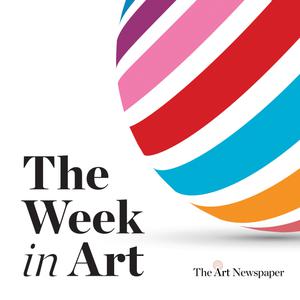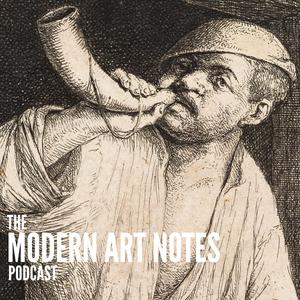
Hyperallergic
Hyperallergic
A weekly collection of news, developments, and stirrings in the art world with host Hrag Vartanian, cofounder and editor-in-chief of Hyperallergic..
- 1 hour 7 minutesFrom Blog to Book
Since 2009, Hyperallergic has published tens of thousands of articles about art. But who are the writers behind these posts? And what drives them to write about art of all things?
Many of the authors who have passed through our virtual hallways have gone on to do incredible things, including publishing books on topics that they first wrote about or more fully developed through articles in Hyperallergic. In 2022, we held an event called “From Blog to Book” at Brooklyn’s pinkFrog cafe, where our Editor-in-Chief Hrag Vartanian asked three of our writers to tell us about the journeys that took them from 140-character tweets to 1,200-word posts to full manuscripts.
Erin L. Thompson, who holds the title of America’s only art crime professor, is the author of dozens of articles that brought looted artifacts from around the world to light. Her adventures have brought her from the Confederate monument etched into the side of Stone Mountain, Georgia, which she wrote about in Smashing Statues: The Rise and Fall of America's Public Monuments (2022), to a rededication ceremony of a repatriated object in Nepal.
AX Mina, who wrote Memes to Movements: How the World's Most Viral Media Is Changing Social Protest and Power (2019), describes how they first explored the topic of memes in Hyperallergic — which they termed “the street art of the social web” before “meme” became the mainstream — and their function as a tool to circumvent internet censorship in China.
And Michelle Young, author of Secret Brooklyn: An Unusual Guide (2023), tells us about her trajectory from working in fashion to playing in the band Kittens Ablaze to discovering so many hidden gems while aimlessly wandering the city she calls home that she founded the brilliant website Untapped New York. It was only in her time off reading World War 2 nonfiction that she found a new trail, which led her to uncover the stories of stolen Nazi loot.
They’ll reflect on finding focus by retreating to a mountaintop in China, unearthing the legacy of forgotten World War II heroes, and even seamlessly forging Picassos — which, as you’ll hear in the show, is not nearly as hard as you’d think.
The music in this episode is by Famous Cats and Cast Of Characters, courtesy of Soundstripe.—
4 April 2024, 5:06 pm - 1 hour 30 minutesThomas Lanigan-Schmidt: The Story of One of the Few Artists at the Stonewall Uprising
We are thrilled to be back with a new episode of the Hyperallergic podcast.
For our one hundredth episode, we spoke with legendary collage and mixed media artist Tommy Lannigan-Schmidt. His works, made from crinkly saran wrap and tin foil, emulate the gleam of precious metals and jewels in Catholic iconography. They reference his upbringing as a working class kid and altar boy in a Catholic community in Linden, New Jersey, where tin foil was an expensive luxury they could rarely afford. But they also hold memories of where he found himself as a teenager: the LBGTQ+ street life and art community of New York City, which led to his participation in the 1969 Stonewall Uprising.
Lanigan-Schmidt is as much a visual artist as he is a storyteller. We climbed up to his fourth floor walk-up in Hell's Kitchen, where, surrounded by teetering piles of books and artwork, he regaled us with tales about artists like Jack Smith and Andy Warhol, his decision to leave his hometown as a penniless teenager, his steadfast identity as a working class artist, his conversion to Russian Orthodox Christianity, what changed for gay artists in New York between the 1960s and today, and of course, his recollection of that historic night at the Stonewall.
We know you’ll enjoy this artist’s sparkling humor and singular vision as he shares reflections on his life and this critical moment in history.
We also talked with Ann Bausum, author of Stonewall, Breaking Out in the Fight for Gay Rights, about the significance of the uprising. She also shared some of her own first-hand recollections of segregation in 1960s America.
The music in this episode was written by Garen Gueyikian, with the exception of one track by Dr. Delight, courtesy of Soundstripe.
A selection of Thomas Lanigan-Schmidt’s work will be on display at a show titled Open Hands: Crafting the Spiritual at Saint Louis University’s Museum of Contemporary Religious Art until May 19, 2024.
- (00:00) - Intro
- (02:31) - Ann / Hrag
- (13:58) - Intro to Tommy
- (15:49) - Tommy / Hrag
- (01:30:05) - Outro
Related Links:- Thomas Lanigan-Schmidt's 2012-2013 solo show at MoMA PS1, Tender Love Among the Junk
- Lanigan-Schmidt's work at Pavel Zoubok Fine Art
- Gay and Proud, the 1970 film which documented a demonstration on Christopher Street on the first anniversary of the Stonewall Uprising, excerpted in this episode starting at 14:39
- Stonewall: Breaking Out in the Fight for Gay Rights by Ann Bausum
- Watch Flaming Creatures by Jack Smith
- Dr. Wendy Schaller on Feast of St. Nicholas by Jan Steen
- Andy Warhol's portrait of Holly Solomon
- Mario Banana, an Andy Warhol film with Mario Montez
—
21 March 2024, 7:24 pm - 1 hour 13 minutesThe Cartoonist the US Right-Wing Political Establishment Loves to Hate
If you’ve been online, and especially on Twitter, then you probably know the name Eli Valley and his brushy drawings that use the grotesque and absurd to make larger points about life, culture, and politics. But it wasn’t until the Trump administration that the New York City-based cartoonist was propelled into the public spotlight. Valley was attacked by a wide range of politicians, particularly Republicans, including Meghan McCain, who called the comic he drew of her “one of the most anti-Semitic things I have even seen.” McCain is not Jewish, and Valley is, not to mention that his father is a rabbi.
In this conversation, I asked Valley to tell us about how he got his start in comics, how he builds on the long history of satire and graphic humor in the Jewish American tradition, and how he copes with the public spotlight while he struggles to survive as a full-time artist.
This podcast is accompanied by scholar Josh Lambert’s article, which explores the art historical roots of Valley’s art. Lambert writes, “Valley comes naturally by his most pressing and recurrent theme: lies told and violence committed in the name of Jewish safety and security. His cartoon jeremiads can easily enough be fit into a long history of Jewish protest, from the Biblical prophets who excoriated the sinners of Israel to modern novelists who, like the criminally under-appreciated late-19th-century San Francisco writer Emma Wolf, wrote about Jews, as she put it, ‘in the spirit of love — the love that has the courage to point out a fault in its object.’”
The music for this episode is “A Mineral Love” by Bibio, courtesy Warp Records.
6 May 2022, 5:45 pm - 1 hour 19 minutesArtists Tali Hinkis and Daniel Temkin Discuss Digital Combines
Artists Tali Hinkis and Daniel Temkin have been at the leading edge of digitally informed contemporary art that explores the boundaries of programming, digital aesthetics, and the handmade. Their work is certainly unique, but they also share some commonalities around media-based art, glitch, and how their work in the gallery and online is circulated and experienced. I invited them to join me for a conversation to hear the thoughts of two intelligent artists who are fully engaged with the new wave of thinking around digital practices in the arts. Hinkis and Temkin are both participating in various “Digital Combine” exhibitions curated by artist Claudia Hart, who coined the term based on artist Robert Rauschenberg’s earlier “Combines” concept that intersects sculpture and painting. In this new incarnation, the digital and analogue are in dialogue.
I also invited both artists, who are of Jewish descent, to reflect on their cultural heritage and how it manifests and informs their larger bodies of work. This conversation is part of a continuing series we’ve been doing over the last year with the help of CANVAS, a foundation interested in fostering new Jewish creativity in the 21st century.
Hinkis and Temkin are both exhibiting together in Digital Combines at Bitforms gallery in San Francisco until January 11, 2023.
The music for this episode is “Ultra (Yung Sherman Mix)” by Evian Christ, courtesy Warp Records.
29 April 2022, 7:44 pm - 56 minutes 23 secondsTamara Lanier's Fight for the Photographs of Her Enslaved Ancestors at Harvard
Last year, we published a dossier of statements by leading scholars supporting the fight of Tamara Lanier to reclaim the daguerreotypes of her ancestors from the Peabody Museum at Harvard University. Lanier, who lives in Norwich, Connecticut, had long heard stories through her family about an ancestor named Papa Renty, a learned man from Africa who was enslaved and brought to the United States under inhumane conditions. Those stories about Renty were important to her family and to the memory of their heritage that they kept alive.
Then one day, Lanier discovered that there were photographs of her relative, and they were deposited at Harvard University because of a 19th-century racist academic named Louis Agassiz. Agassiz had commissioned them to "prove" his White Supremacist ideas about race and they lay in a trunk at the Peabody Museum until a researcher resurfaced them in the 1970s.
In this podcast, I speak to Lanier about the continuing fight to reclaim her family heritage by asking Harvard to accept her right to the ownership of the images. She discusses a fascinating visit to the home of descendants of the Taylor family, enslavers who claimed Lanier's ancestors as property, and some surprising discoveries she made along the way.
This is a must-hear episode, and I would highly recommend reading Valentina Di Liscia's excellent article, which was part of our special dossier, that summarizes the history of the court case and the larger fight to "Free Renty."
Lanier has also allowed us reproduce some of the photographs she took at the Taylor family home, which includes various items of furniture created by her ancestors when they were enslaved.
Related Links:
- The Continuing Fight to #FreeRenty
- Legal Precedents or Reparations? Lawsuit Against Harvard May Decide Who Owns Images of Enslaved People
---
Subscribe to the Hyperallergic Newsletters
Become a Member21 April 2022, 8:13 pm - 23 minutes 38 secondsUnderstanding Why a Harvard Museum Will Return Standing Bear’s Tomahawk
Something incredible happened a few months ago. After Oklahoma lawyer Brett Chapman (Pawnee) started tweeting about the tomahawk of Ponca Chief Standing Bear, which is currently in Harvard University’s Peabody Museum of Archaeology and Ethnology in Cambridge, Massachusetts, the revered object may actually be going home.
His short messages asked why the tomahawk was in the care of that institution and not with one of the two federally recognized Ponca tribes. The questions raised eyebrows, and as Cassie Packard reported for Hyperallergic, the museum later posted a statement on its website explaining that the museum and the Ponca tribe are “in active discussion about the homecoming of Chief Standing Bear’s pipe tomahawk belonging to the Ponca people.”
Chapman, who has Ponca heritage, joins me for this podcast to explain the history of the tomahawk and why the return of the heirloom is important.
Subscribe to Hyperallergic on Apple Podcasts, and anywhere else you listen to podcasts.21 July 2021, 7:54 pm - 1 hour 36 minutesAudrey Flack and the Last of the New York School
A painter who may be best known for her contribution to the Photorealism movement, Audrey Flack has been a working artist for roughly 70 years. Now at age 90, Flack reflects on the art world, from her days as part of the New York School of artists in the 1950s and 60s; her rise to fame as the only prominent female Photorealist; her embrace of sculpture and public art in the 1980s and 90s; and her return to painting only a few years ago.
In this wide-ranging conversation, Flack also shares her experiences in college with renowned modernist Joseph Albers; a strange and unnerving experience with renowned painter Jackson Pollock; how she coped raising children through all of this; and much more. We’re joined by artist Sharon Louden, who is a mutual friend of Flack and myself.
This is Flack's first-ever podcast, and I'm excited for you to hear the story of this incredible artist who continues to push us to see the world anew. I hope you enjoy this epic interview with the talented artist.
The music in this episode is Ultra (Yung Sherman Mix) by Evian Christ, courtesy of Warp Records.
Subscribe to Hyperallergic on Apple Podcasts, and anywhere else you listen to podcasts.
16 July 2021, 8:53 pm - 52 minutes 44 secondsCollector Tim Kang Talks About His Love of NFTs
Tim Kang started his career as a software engineer for Deutsche Bank and invested a year of savings in Ethereum in early 2016, and let’s just say it’s paying off. The North Carolina native, who is known online as “illestrater,” is now a digital art collector and purchased works by Murat Pak and Beeple before all the recent auction sales and press coverage propelled them into the spotlight.
He’s founded other artist platforms, including CUE Music and Universe.XYZ, and his latest organization, Sevens Foundation, is offering “Sevens Genesis Grants” for emerging and underrepresented artists to mint their first NFT. Kang calls himself a “champion of BIPOC and LGBTQ+ artists” in the NFT space.
I spoke to him to learn more about his interest in NFTs and collecting digital assets and his thoughts on the future of the field.
This is a continuation of a series of podcasts we’re publishing on the evolving terrain of NFTs and their impact on artists and the arts community.
The music for this episode is “Autowave” by Kelly Moran from the album Ultraviolet, which is available from Warp Records.
Subscribe to Hyperallergic on Apple Podcasts, and anywhere else you listen to podcasts.
31 May 2021, 3:00 am - 43 minutes 39 secondsCreative Time’s Diya Vij Helps Launch an Art World Think Tank
Diya Vij started her new job as Associate Curator of Creative Time just last fall, in the midst of the pandemic. She has since announced the first Creative Time Think Tank cohort, which includes La Tanya S. Autry, Caitlin Cherry, Sonia Guiñansaca, Namita Gupta Wiggers, and a number of other engaged voices of the art community. This new initiative invited people to submit proposals for an open call, drawing 200 individual or group applicants. The selected cohort will meet regularly for the next 10 months to reflect on the realities around us and imagine a way forward for the cultural sector.
Vij has built a reputation over the years for her work at the Queens Museum, High Line, and in the Commissioner’s Unit of the New York City Department of Cultural Affairs, where she created the Public Artists in Residence program. She joins me to discuss this unusual think tank and what the collective hopes to accomplish.
Music is Lorenzo Senni’s “Move in Silence (Only Speak When It’s Time to Say Checkmate)” from Warp Records.
Subscribe to Hyperallergic on Apple Podcasts, and anywhere else you listen to podcasts.
11 May 2021, 4:00 am - 49 minutes 26 secondsAfter Decades of Selling New Media Art, Gallerist Steven Sacks Offers His Take on NFTs
Since 2001, Bitforms gallerist Steven Sacks has been exhibiting and selling digital art (though he hates that term) and building an audience and support network for artists working with new media.
After Sara Ludy, one of the artists Bitforms regularly exhibits, told Hyperallergic about her plans to negotiate new more equitable contracts for any NFT she sells, I decided to speak to Sacks to hear about his experience during this pandemic period when NFTs dominate many mainstream conversations about online and digital art. He talks to me about selling art, how things have evolved, and what he expects from this new wave of change. Galleries, Sacks suggests, will always be relevant.
This is the third podcast in a series of episodes and articles we will publish in the coming weeks on the topic of NFTs.
Subscribe to Hyperallergic on Apple Podcasts, and anywhere else you listen to podcasts.
30 March 2021, 8:18 pm - 52 minutes 40 secondsLindsay Howard Talks About the Burgeoning Market for NFTs
Lindsay Howard is the head of community at the Foundation, one of the new platforms that have been part of the current wave of NFT art. She joined me in our Brooklyn studio to discuss the audience for crypto art and the collectors eager to fork over money for it. We also delve into what it could mean for an art scene facing the fact that the post-pandemic world may be very different for creators, sellers, collectors, journalists, scholars, and everyone else.
This is the second podcast in a series of episodes and articles we will publish in the coming weeks on the topic of NFTs.
Subscribe to Hyperallergic on Apple Podcasts, and anywhere else you listen to podcasts.
9 March 2021, 9:36 pm - More Episodes? Get the App
Your feedback is valuable to us. Should you encounter any bugs, glitches, lack of functionality or other problems, please email us on [email protected] or join Moon.FM Telegram Group where you can talk directly to the dev team who are happy to answer any queries.
 ArtCurious Podcast
ArtCurious Podcast
 The Week in Art
The Week in Art
 The Great Women Artists
The Great Women Artists
 The Art Angle
The Art Angle
 The Art Career
The Art Career
 The Modern Art Notes Podcast
The Modern Art Notes Podcast